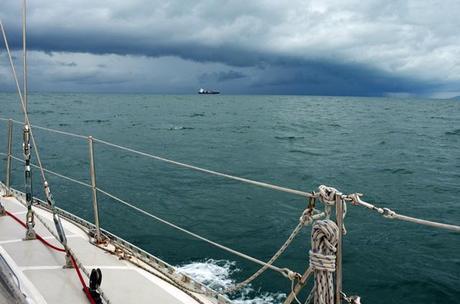
Well, that was unpleasant.
There are the beautiful days of white sandy beaches and gin-clear water, and then there are the days when you have your ass handed to you by the weather.
We spent just over a week knocking off a list of projects from rig tuning to galvanizing in Penang. It’s probably our last marina stay until we arrive in South Africa, more than a year from now, and some things are just easier to do at a dock when the boat is relatively motionless and the fresh water runs freely. But we were ready to get out and back in our happy place, rocking gently at anchor.
Totem slipped out in the morning from Straits Quay marina, waving goodbye to friends and poking out into the gray. Since we were heading generally north during the monsoon season that brings southwesterly winds, this was supposed to be a mild stretch with light daysails. Checking a few different forecasts made it look a little less pleasant; we’d have moderate headwinds, probably, and rain. But it as nothing worth changing plans for, and we were ready to head north. With a little more breeze, maybe we’d even get some sailing in!
Waterspouts are chilling
Penang was still in sight behind Totem when the squalls started forming. Jamie had hoped for a nap after a late night (fueled by delicious homemade chicken vindaloo brought to the boat by a new friend) and was resting below. The first few cells passed behind us and he might have gotten a nice break if we had more “normal” passing squalls, but that all changed with a waterspout forming and heading right towards Totem. Sorry honey- we need all hands! I wish I had a photograph, but it was a whole lot more important at the time to make sure we were prepared for the worst. While we scrambled, it approached, then wavered, then thankfully dissipated.
And then we lost visibility
Generally, the squalls we have in the area where the gust top out around 40 knots. Nothing to sniff at, but relatively manageable. This time, our sustained winds were in the 40s, and the gusts nearly 60. Not fun. Initially, the rain beat seas down to near flat, and gave us close to whiteout conditions.
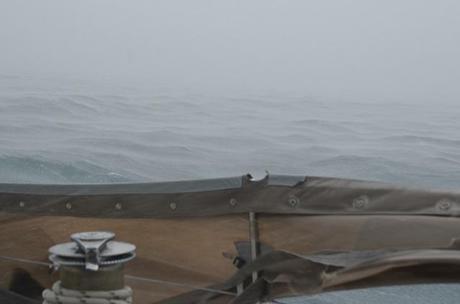
Truly unpleasant seas
Later, even the torrential rain couldn’t keep sea state down. With the wind howling, we had a few hours of 4 meter peaks and the occasional pile-up above that. Totem was stowed down below in anticipation of a more typical day along the peninsula, not this kind of weather. The cabin was trashed with books and papers and the odd bit of cookware (that cast iron pan JUST missed my foot). At least the only casualty was our carved Komodo dragon’s tail. It’s not his first dismemberment and is fixed easily enough.
A radar would really help here
We don’t have a radar right now. Ours died about a year and a half ago, possibly the result of a near-lightning strike in the Banda islands. We never had a clear diagnosis since Raymarine refused to service the (still sold at retail) unit because it was “old technology”… so they’re not on the list of vendors for our next radar, which we hope to install before crossing the Indian Ocean.
Radar would have been nice in the low visibility, for sure. There weren’t a lot of other boats around us, and the fishermen all seemed to have wisely chosen to stay at home- unlike pretty much every other day along this coast we weren’t dodging fishing nets. But more importantly, if we’d had a functional radar, we could have seen what was happening with the weather as conditions evolved. Much sooner, we would have realized that this wasn’t just another squall blowing through, this was a bigger system and we had hours of bad weather ahead. We’d almost surely have made a U-turn and gone back to Penang. Even if we we had to anchor outside the marina, we’d have been protected from the worst in the lee of the island.
I thought we just fixed the engine?
When the rain slowed to drizzle and the wind backed off to the 30s and we could hear the engine again. While we were in Penang, Jamie fixed contacts to the engine gauges. They’d been inaccurate (or simply unresponsive) since the 5,000 hour service. They worked in the marina, but just our luck that they stopped working again, so our senses were the only way to guess at RPMs. With conditions mellowing the sounds of the engine made it clear that throttling up did not result in more power. Apparently, our slow speed was due to more than just headwinds and adverse current! When throttled up, the turbo on our Yanmar 4JH3/TE wasn’t kicking on. Speculating it was fuel starved, Jamie checked through the filters. Although our primary racors had been recently replaced (after fuel polishing in Puteri), they were full of crud. Most likely all that sloshing around in the seas had dislodged any bit of grit remaining in the tanks. Swapped, replaced, on again and… still not running. Now the engine is practically hiccuping. We’re bounding around, and I’m just waiting to hear it sputter and stop. This is not a good time to deal with blocked filters.
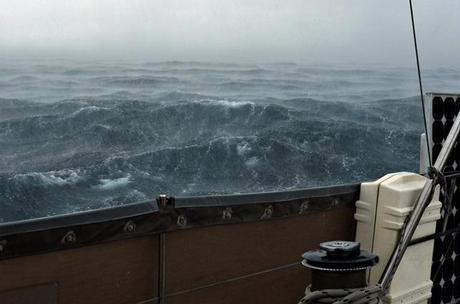
Jamie replaced the secondary filter, which we can’t see inside, but we speculate must also be gumming up. Engine on again and… normal again, but only briefly. It didn’t take long until the cycling sound of the engine losing power resumed. NOW what? The last line between tanks and engine is the Algae-X. Sure enough, great icky globs of bio gunk are stuck all over inside. Cleaned it out, fired up again, and finally we’re off and running smoothly.
At least there wasn’t lightning
Have I mentioned that this weather was all right on the nose? So much for fair/following in the southwest monsoon. Slow progress had doomed us to an after-dark arrival. We had our old tracks into the maze of channels and islets at the south end of Langkawi, but with the weather continuing to look unpleasant, we wanted to get tucked up safely as quickly as possible. So breaking our rule to avoid anchoring in a new place after dark, we angled up into what looked like a well protected bay and dropped the hook. Not quite 360 protection but well buried inside, we looked forward to a good night’s rest after a celebratory dinner of carbonara – a family favorite.
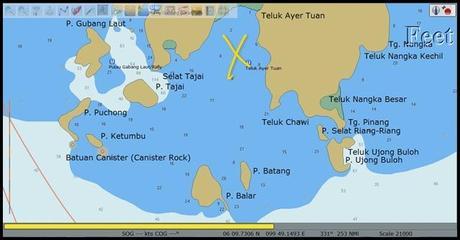
X marks the spot on OpenCPN
Unfortunately, even getting way up inside that little bay with all the islets outside to deflect, it was pretty rolly. Not gunwhale to gunwhale, but just enough to make you keep an eye on your drink and watch where something is put down, and plenty to prevent a good night’s sleep. And then- more squalls, in the inky night, with the moon well hidden in the clouds. For only the second tie in six years, we dragged anchor. Jamie’s stoic: “looks like I’m going to be awake for a while!” And he will, so I get some rest. At least one of us would be functional enough to make coffee in the morning!
At rest
No pretty beach. No turquoise water. But for a while there, I could even forget that our refrigeration had recently broken, and we’d recently entered the ranks of “ice is nice” and had a stash of perishables to cook through before they go bad!
Mostly? I’m grateful for a calm, capable co-captain who truly has an iron stomach. I’m grateful the kids handle rough conditions so well. And I’m thankful to have a boat that is even stronger than we are.
Well fueled boaters know we love it when you read this on the Sailfeed website.
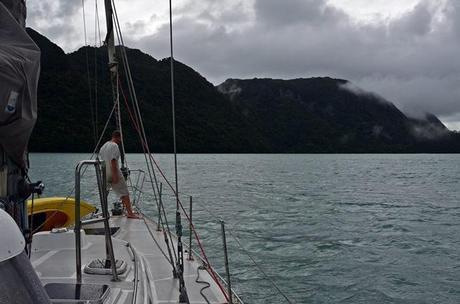
Raising anchor, the morning after

